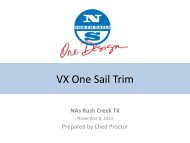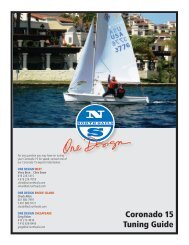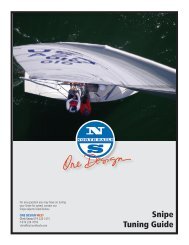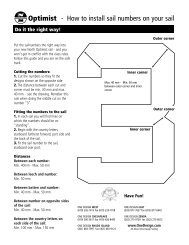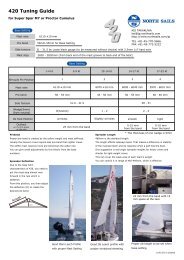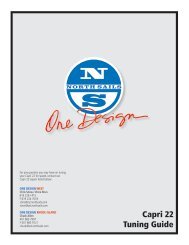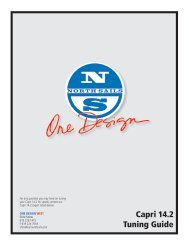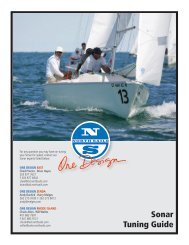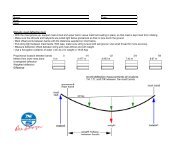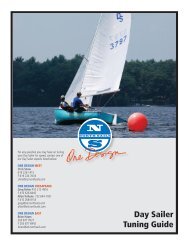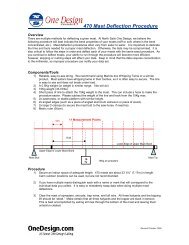J/24 Tuning Guide - North Sails - One Design
J/24 Tuning Guide - North Sails - One Design
J/24 Tuning Guide - North Sails - One Design
You also want an ePaper? Increase the reach of your titles
YUMPU automatically turns print PDFs into web optimized ePapers that Google loves.
NORTH SAILSJ/<strong>24</strong> <strong>Tuning</strong> <strong>Guide</strong>San Diego <strong>Design</strong>sAs the above chart shows it is importantto change your settings depending onthe condition. Be aware that as thewind builds and dies you will need to beconstantly adjusting the tension on thegenoa sheet.CLASS JIBFor fine-tuning the lead position, drill twoextra holes between each set of factoryholes in the jib track. Start with the jiblead block positioned at the chainplatesand fine tune the lead position from there.Unlike the genoa the luff of the jib shouldalways be smooth. Be careful, you can inmoderately heavy air get the luff too tight.The luff of the sail should break evenlyup and down. If the sail breaks high firstmove the lead forward, low first move thelead back. Check this carefully and make aMAINSAIL SETTING CHARTWind Speed Traveler Backstay Top Batten Angle Outhaul0-6 knots All way up None Closed 3 degrees In ½”7-12 Down 3-4” ¼ on Closed 3 degrees to parallel Max. tight12-18 Middle ½ to ¾ on Parallel to open 3 degrees Max. tight18+ Below CL 2-3” Max on Open 3-6 degrees Max. tightGENOA SETTING CHARTCondition Lead Halyard Sheet0-6 flat 1 aft of neutral Wrinkles 3-4” off spreader0-6 choppy On Neutral Wrinkles 3-6” off spreader7-13 flat On Neutral Just Smooth 2-3” off spreader7-13 choppy 1-2 holes fwd. Wrinkles 2-4” off spreader14-18choppy 1-2 holes fwd Smooth 4-6” off spreader18+ On neutral Tight 6-8” off spreadermark on the deck in the correct spot.Sheet tension is critical. We like to adjustthe tension on the jib sheet to balance outthe helm of the boat. If the boat has a bitof weather helm trim the jib slightly to pullthe bow down. If the boat has leewardhelm ease the jib slightly. Keep in mindthat you only need to change the tensionon the sheet very slightly (1/2” increments)to have a real effect on the trim of a highaspect sail like the jib.SPINNAKERThe spinnaker should be at full hoist at alltimes. The general rule of trim is to allow2-4" (50-102 mm) of curl in the luff of thesail. The outboard end of the pole shouldbe even with the free floating clew and thepole should remain perpendicular to theapparent wind. Use the upper pole ring formost conditions. If you are going slow tryraising the pole a couple of inches.DOWNWIND — LIGHT AIRConcentrate on good communicationbetween helmsman and spinnaker trimmer.The goal is to sail as low as possiblewhile still maintaining good pressure inthe spinnaker (measured by tension onthe sheet). Try not to sail too high whichtranslates into longer distances, but do notsail too low at a slow pace. Be careful notto pull the pole too far aft which flattensthe spinnaker.DOWNWIND — HEAVY AIRBe careful not to square the pole back toofar as this makes it easier for the spinnakerto roll out to weather. Do not let the clewof the spinnaker go past the headstay.Keep most of the crew hiked on theleeward side in order to sail low and notrisk rolling to weather.DOWNWIND TIPSPole height is important and changesin increments of 1" (25 mm) have a bigeffect on the spinnaker. The break the sailshould curl evenly from top to bottom . Ifthe spinnaker breaks high, the pole is toolow and should be raised. If the break islow, the pole is too high and should belowered.Whether or not you use tweakers (ortwings), an efficient foreguy system iscrucial. Every up and down, or back andforth motion of the pole (and hence thespinnaker) is wasted energy; that energywill not be pulling the boat forward.An efficient system for launching andretrieving the spinnaker is a must. Werecommend a deep cockpit launching bag.Call us if you would like one made for yourJ/<strong>24</strong>.Visit our web site at www.<strong>One</strong><strong>Design</strong>.com for the latest J/<strong>24</strong> news and tuning tips.© <strong>North</strong> <strong>Sails</strong> <strong>One</strong> <strong>Design</strong>. All rights reserved.4
NORTH SAILSJ/<strong>24</strong> <strong>Tuning</strong> <strong>Guide</strong>San Diego <strong>Design</strong>sIn conclusion:Always sail the boat as flat as possibleexcept for very light airSail as close to max weight limit of 400kgs as possible.Do not be afraid to change settings ifyou are slow.Keep a tuning chart and use it.Have open positive communication onboard.Sail fast and have fun!Appendix AJ<strong>24</strong> Sail CareYour <strong>North</strong> <strong>Sails</strong> are constructed out ofthe best materials on the market today.We make sure of this by testing every rollof cloth we use. Through proper care andmaintenance your sails will give you theperformance you have come to expectfrom a <strong>North</strong> SailThe most important factor for a long lifefor your sails is to watch them for signsof wear and tear in high load and chafeareas. Be sure to wash the sails off withfresh water and dry the sails thoroughlybefore storing. A dry, mild climate is best.Excessive heat can cause problems withthe sails due to the possibility of shrinkage.It is best to roll the mainsail, genoa, andjib.MAINSAILWhen hoisting and lowering the sail tryto minimize the amount of creasing orwrinkling of the sail. Every time the sailgains a crease the cloth breaks down thatmuch faster. Always have someone containthe leech and luff during these procedures.The battens can be left in the sail withoutany problems. Be sure to roll the sail downthe leech so that the battens will not twist.This could cause damage to the battens.GENOAWith today's Mylars becoming softer thisprocess has become more difficult. Whenfolding, creasing can develop from foldsand accelerate the breaking down of theMylar. The worse case scenario is for thesail to be rolled and then folded.JIBWhen rolling the jib keep the battensperpendicular to the leech. Pay specialattention to the battens and battenpockets for wear and tear. Since this sail ismanufactured from yarn tempered Dacron,problems can arise due to mishandling.SPINNAKERThe spinnaker is fairly straight forward. Besure to repair all tears and pulled stitches.Folding the sail when storing is best.Appendix BJ<strong>24</strong> Racing ClinicsThis tuning guide only begins to cover allthere is to know about racing the J/<strong>24</strong>.The J/<strong>24</strong> team at <strong>North</strong> <strong>One</strong> <strong>Design</strong> hasprepared a professional, in depth J/<strong>24</strong>racing clinic that you and your fleet will beinterested in learning more about. In thecourse of an evening or weekend you willlearn more about racing your J/<strong>24</strong> thanyou could possibly learn in a season ofracing on your own.Please call you nearest <strong>North</strong> <strong>Sails</strong> <strong>One</strong><strong>Design</strong> International loft for completedetails!At <strong>North</strong> <strong>Sails</strong> we are constantly striving tomake our products better. If you have anycomments on this tuning guide and how itcould be improved for your purposes we'dlove to hear from you. Please give us a callor drop us a line.TENSION GAUGE CONVERSIONCHARTOver the past few year Loos Co. hasintroduced it's new style PT-1, 2 and 3professional tension gauges to the market.Since many of us are replacing our oldermodel A and B gauges with these newmodels we are posting the followingconversion chart for your convenience.MODEL A MODEL PT-13/32 1/8 5/325 610 915 12 1420 16 1625 20 1928 23 2130 2235 27 2538 30 2840 33 3042 3344 3645 3846 3947 40Model B Model PT-2 PT-33/16 7/32 1/4 9/3210 1115 1318 1520 16 1822 18 20<strong>24</strong> 19 2226 21 <strong>24</strong>28 23 2530 25 27 2532 27 29 2734 29 31 2933 3136 33 637 36 737 91011121416182025Visit our web site at www.<strong>One</strong><strong>Design</strong>.com for the latest J/<strong>24</strong> news and tuning tips.© <strong>North</strong> <strong>Sails</strong> <strong>One</strong> <strong>Design</strong>. All rights reserved.5
NORTH SAILSJ/<strong>24</strong> <strong>Tuning</strong> <strong>Guide</strong>San Diego <strong>Design</strong>sNORTH SAILS ONE DESIGN QUALITYCONTROL CHECKChecked by: _____________________Date: ____ / ____ / ____MAINSAILCornersCunninghamTack SlugLeech CordRoyaltyNumbersCountry CodeBattensLeech TelltalesInsignia (stitched on)Measurement sticker at head<strong>North</strong> LogoBagJIBCornersBattensCunninghamTelltalesLeech telltalesLeech lineRoyalty (stitched on)Measurement sticker at head<strong>North</strong> LogoBagGENOACornersCunninghamTelltalesLeech telltalesLeech lineLuff HanksTacking LineSpreader and stancion patchesCountry Code and NumbersRoyalty (stitched on)Measurement sticker at head<strong>North</strong> LogoBagSPINNAKERCornersNumbers (one side)Country Code (one side)Royalty (stitched on)Measurement sticker at head<strong>North</strong> LogoBagVisit our web site at www.<strong>One</strong><strong>Design</strong>.com for the latest J/<strong>24</strong> news and tuning tips.© <strong>North</strong> <strong>Sails</strong> <strong>One</strong> <strong>Design</strong>. All rights reserved.6



